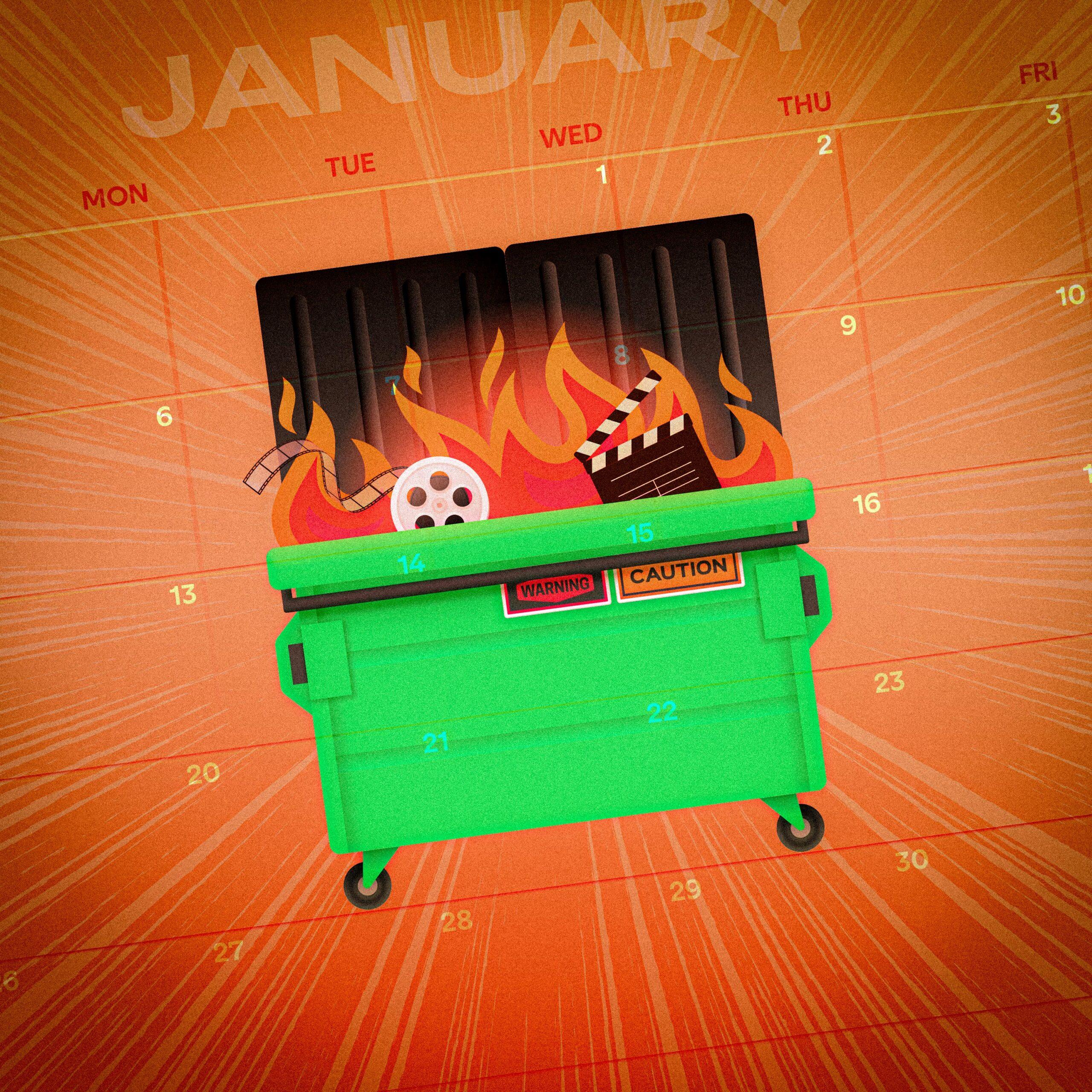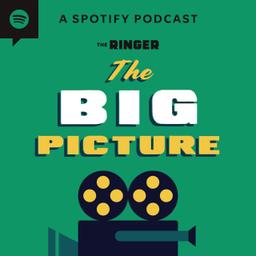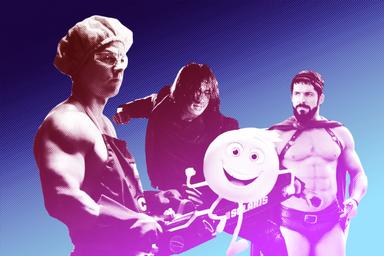
Dumpuary is not just a studio release window. It is a state of mind. To paraphrase the French philosopher Jean-Paul Sartre: To see a bad movie in January is as lovely as to go for a walk in June.
There is, perhaps, something slightly Sartrean about Mel Gibson’s new thriller, Flight Risk, which could have been titled No Exit. Crowded into a single-engine aircraft bound for Anchorage, a dogged U.S. marshal (Michelle Dockery) and her mob-accountant prisoner (Topher Grace) learn that hell is other people—or, more specifically, that hell is Mark Wahlberg, playing sweatily against type as a balding, white-trash contract killer who’s been hired to take out the accountant before he can testify against a notorious gangster.
It’s an assignment that involves masquerading as a freelance pilot, and Wahlberg’s character isn’t exactly a master of disguise. The plane has been in the air for barely 10 minutes before Dockery’s character—who, as per the law of genre cliché, fumbled the last prisoner she had in custody—notices her ride doesn’t seem to know what he’s doing and starts reaching for her Taser. In theory, Flight Risk is a stripped-down, white-knuckle thriller in which a closed space becomes contested territory. The real tension, though, resides outside the story, in watching Gibson—who, for those with short memories, was primarily known for being an Oscar-winning filmmaker before he became Donald Trump’s newly appointed special ambassador to Hollywood and a leading spokesman for ivermectin—try to leverage his eccentricities against the demands of a conventional B-movie narrative. The results are turbulent at best, with the loud clunking of plot machinery drowned out by the spectacular obnoxiousness of Wahlberg’s performance, which draws out the script’s barely veiled subtext of cutting, sadistic homophobia. The best moment of the movie involves a cameo by a spooked-looking CGI moose.
By even the most lenient standard, Flight Risk is a failure; compared to last year’s January standout The Beekeeper—a beefier and more enjoyable action movie with a more fragrant stain of reactionary, deep-state paranoia—it’s especially middling. The Beekeeper is good enough, in fact, to warrant consideration as an all-time January movie—a designation that’s trickier to attain than it seems.
There are a lot of reasons that studios and distributors front-load ostensibly bad movies—everything from reduced box office competition to a general post-holiday pop cultural hangover (and the fact that audiences have been trained to scarf up awards bait in close proximity to the Oscar nominations). It’s therefore easy to mock low-hanging fruit like Flight Risk sight unseen (not that seeing it necessarily helps its case). And while it might seem counterintuitive to try to create something like a Dumpuary Canon, looking back over the past few decades, it’s easy enough to find movies that emerged from the dead zone.
It’s probably important to establish some ground rules. Even though “Dumpuary” is mostly understood to include February as well, the month has simply yielded too many consensus classics to count, including The Silence of the Lambs, Wayne’s World, and, obviously, Groundhog Day. (It’s also when Black Panther came out and made a billion dollars.) It’s also important to note that there’s no place here for festival-circuit holdovers or prestige pictures with wide rollouts on the other side of Christmas. I’m not sure that 2025 will yield 10 mainstream titles more entertaining than Better Man—which is currently tens of millions of dollars short of breaking even at the American box office—but it was technically released on Christmas Day, 2024. As another example, 30 years ago, Richard Linklater’s sublime Before Sunrise came out on January 27, 1995, but it had already premiered to rapturous reviews at Sundance and been programmed in Berlin; it doesn’t seem fair to compare a Silver Bear winner to the likes of Cocaine Bear. The kinds of films that are in contention for this particular canon are ones that feel like they belong in a half-empty multiplex. Since the majority of made-for-streaming content has desperate, January-of-the-soul vibes no matter what, nontheatrical titles are disqualified. Other than that, anything goes.
Alone in the Dark (January 28, 2005)
A question: When you’re alone in the dark, would you rather watch a movie with a 100 percent rating on Rotten Tomatoes or 1 percent? Be honest.
You can trace a direct line from the spectacularly awful critical reception of Uwe Boll’s 2005 video game adaptation to the filmmaker’s “Raging Boll” publicity stunt, in which he challenged internet writers who’d panned his entertainingly inept movie (or any of his other movies) to a series of full-contact boxing matches (all of which he won). It takes a publicity-savvy iconoclast like the Germany-born Boll (who, for the record, holds a PhD in literature) to channel the secret fantasies of every director who’s ever wanted to bludgeon the culprit behind a bad review, and for viewers who enjoy being brutalized by badness, Alone in the Dark is a sadomasochistic delight. The more exposition we get from Christian Slater’s paranormal investigator about the relationship between the emergence of alien creatures and the secret history of an ancient and vanished Native American tribe, the less sense anything makes. It’s a fine line between stupidity and surrealism, and whatever else you can say about Boll’s debacle, it isn’t boring. At one point, Slater pleads with a mad scientist who’s planning (for whatever reason) to open a portal to another dimension. Staring down the end of the world as he knows it, the best our hero can do is yell, “Don’t be insane.” Sadly, he’s in the wrong movie.
The Boondock Saints (January 21, 2000)
A confession: I didn’t make it all the way through Troy Duffy’s cult crime thriller, which plays like a movie by Christopher Moltisanti. It’s not nearly as entertaining as the documentary about the circumstances behind its creation. Writer-director Troy Duffy was a New England–born bartender who managed to parlay a series of scuzzy life experiences (and multiple viewings of Reservoir Dogs) into a much-sought-after screenplay; somehow, despite his lack of talent, track record, and social graces, Duffy got Willem Dafoe to play the lead and decamped to Toronto, shooting with a smaller budget than planned. As a movie, The Boondock Saints is an ugly and witless pastiche; as a case study in how home video (including unusually active participation and promotion by Blockbuster) once had the power to help a film find an audience, it’s endlessly compelling.
Dirty Grandpa (January 22, 2016)
With apologies to The Irishman and Killers of the Flower Moon, the ultimate late-period Robert De Niro performance may be his role as retired Lieutenant Colonel Richard “Dick” Kelly in Dirty Grandpa, a proudly raunchy, intergenerational, spring-break sex comedy that features its Oscar-winning star rapping the near entirety of Ice Cube’s “It Was a Good Day” at karaoke. “I want you to tear open my bra like it’s a social security check,” purrs Aubrey Plaza as a spring breaker who keeps throwing herself at Dick. She’s hilariously unhinged in a part that takes advantage of her fearlessness, while Zac Efron is perfect in a straight-man role that’s mostly just a catalog of abjection and abasement (including smoking crack on the beach and waking up with a penis-shaped swastika on his forehead). Critics were predictably horrified, but there’s more honest, dudes-rock comic energy in Dirty Grandpa than in your average Apatow-brand comedy (and better jokes, too). Maybe you can resist hearing De Niro refer to Efron, whose character has designs on law school, as “Alan Douchewitz.” If so, you’re made of stronger stuff than me.
The Mothman Prophecies (January 25, 2002)
A post–X Files exercise in parapsychological paranoia, The Mothman Prophecies is also one of the creepier studio horror movies of its era, including what has to be the freakiest use of chapstick in film history. Crucially, director Mark Pellington never condescends to the material, treating the titular cryptozoological curiosity seriously, both as a monster and a manifestation of individual and social anxiety; as a journalist trying to unravel the mystery of the Mothman (and its connection to the accidental death of his wife), Richard Gere manages to seem authentically haunted—and authentically, it’s one of his best performances. Whatever you think about the supposedly fact-based nature of the story line in The Mothman Prophecies, there’s something admirable in the way it refuses to reduce down to disposable entertainment. There’s no escapism here, just a pervasive sense of doom that, in its moody way, feels cathartic and even comforting. Science can’t explain everything; evil is omnipresent and elusive; bad things happen to good people; grief is hell; terror and bewilderment are, finally, preferable to guilt.
Movie 43 (January 25, 2013)
Speaking of Richard Gere, he’s one of the dozens of A-list actors who got roped—or maybe hog-tied—into appearing in producer Charles B. Wessler’s grand experiment, a cinematic analogue to the then-emergent comedy website Funny or Die, made up of unconnected, absurdist, hard-R-rated short films. (Other names on the call sheet include Kate Winslet, Naomi Watts, Uma Thurman, Emma Stone, a pre-mega-fame Jeremy Allen White, and so many more.) The movie was shot over a period of several years with multiple directors; the performers were paid a grand total of $800 per day each for their time. Dennis Quaid appears as Wessler, holding a studio executive at gunpoint while explaining his idea. In one segment, Hugh Jackman plays a man with testicles dangling from his neck; in another, Anna Faris reveals to Chris Pratt that she’s a coprophiliac. On it goes, through scenes featuring brutal violence and sexual humiliation, jokes involving incest and bestiality, and Gerard Butler in a dual role as angry, fraternal leprechauns. Some of it is very funny, some of it is arguably transgressive, and the rest is productively irritating. Let’s put it this way: There are worse legacies than baiting Richard Roeper into calling your movie “the Citizen Kane of awful.” (And for what it’s worth, Dennis Quaid had a good time making it.)
The Relic (January 10, 1997)
They don’t make them like this anymore: a (mostly) analog creature feature (with special effects by the great Stan Winston) pitting the staff of the Field Museum of Natural History in Chicago (and a cop played by Tom Sizemore) against a mythical monster inadvertently imported to their collection from South America. Directed by veteran genre specialist Peter Hyams—at that point coming off of two consecutive, excellent Jean-Claude Van Damme vehicles, Sudden Death and Timecop—The Relic contains images that are steeped in shadows to the point of seeming borderline avant-garde. But the centerpiece sequence, featuring a bunch of stuffy society types getting mauled to death at a fancy fundraiser, is preposterously satisfying.
The Stepfather (January 23, 1987)
A diabolically funny send-up of Reagan-era values about a smiling, suburban patriarch with a serious dark side, The Stepfather arrived in theaters without much hype—although Pauline Kael was a fan, calling it a “cunning, shapely thriller.” Its namesake is a would-be patriarch who moves between identities and households in an attempt to mold each successive family in a perfect, Norman Rockwell image; the implication is that when he invariably ends up killing the wives and children before skipping town, it’s as punishment for his failures as well as theirs. Throughout the movie, director Joseph Ruben evokes the films of Alfred Hitchcock, including a shower scene indebted to Psycho and scattered nods to Shadow of a Doubt, which it resembles as a fable of innocence lost (another good comparison from the same mid-’80s period: Blue Velvet). “Wait a minute … Who am I here?” asks Terry O’Quinn’s Jerry Blake during a tense and hilarious moment of psychic slippage. The Stepfather is trash, but it’s also a harrowing and enduring portrait of the cipher next door.
Tales From the Crypt: Demon Knight (January 13, 1995)
“I was happy to do the first film where an African American woman saves the world,” said Ernest Dickerson of his Tales From the Crypt spinoff, which is, among other things, a much better mash-up of Western and horror tropes than From Dusk Till Dawn, which came out the following year. As you’d expect from a movie directed by Spike Lee’s regular cinematographer, Demon Knight looks beautiful, with moody, blue-hued lighting and outrageous practical gore effects (including a face caved in by a single punch and a decapitated head that gets hurled like a bowling ball). Meanwhile, Billy Zane’s performance as a vain, bald demon trying to hijack the keys to the cosmos approaches the platonic ideal of scenery chewing. “Don’t scream,” smiles Zane at one point. “Just hear what I’ve gotta say and then scream.” He’s priceless, and Demon Knight is worthy.
Torque (January 16, 2004)
Music video ace Joseph Kahn said he was deliberately trying to spoof The Fast and the Furious with Torque, an outrageously stylized thriller featuring candy-colored production design, a throbbing nu-metal soundtrack, and a plot that pivots on a cache of stolen motorcycles loaded with meth. The mockery of Vin Diesel’s meathead metaphysics isn’t exactly subtle: When Martin Henderson’s Cary Ford explains that he lives his life a quarter mile at a time, he’s told that it’s the dumbest thing anyone’s ever said. The best part of that exchange, though, is that one of the guys is named after—wait for it—Henry James. Such non-sequitur absurdity is essential to Kahn’s directorial sensibility, which is why, for all his stylistic virtuosity—and consistent instinct for seizing a 21st-century pop cultural zeitgeist defined by gestures of extreme and sublime stupidity—he tends to confuse audiences. With Torque, Kahn crafted such a convincing impersonation of a bad early-aughts action movie that people took it for the real thing: a Pyrrhic victory that nearly immolated his filmmaking career right out of the gate.






